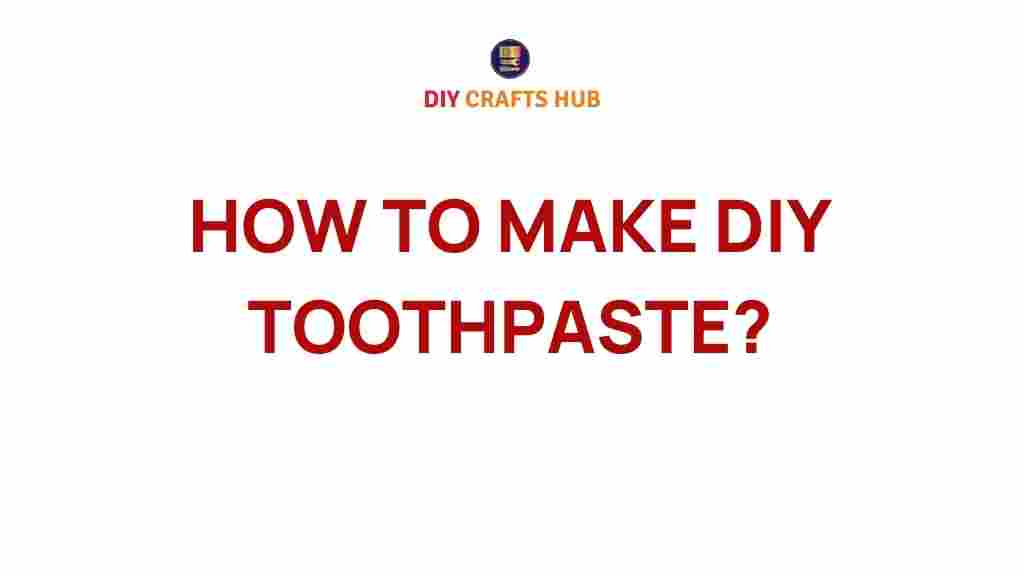What is DIY Toothpaste and Why Should You Make It?
In recent years, people have become more conscious of the chemicals in everyday products. One such product is toothpaste. This has led many to explore making DIY toothpaste at home. But what exactly is it, and why should you consider it?
DIY toothpaste is a natural alternative to store-bought toothpaste, made using simple ingredients found in your kitchen or local health store. By creating your own toothpaste, you can:
- Avoid harmful chemicals like fluoride and sulfates.
- Control the ingredients for sensitive teeth or gums.
- Save money while reducing waste from commercial packaging.
In this guide, we’ll reveal the secrets to making your own toothpaste, troubleshooting common issues, and ensuring your homemade blend is effective and safe.
Step-by-Step Guide to Making DIY Toothpaste
Ingredients You’ll Need
To get started, gather the following ingredients. These can vary based on your preferences and needs:
- Baking soda: A natural whitener and cleanser.
- Coconut oil: Provides a creamy texture and antibacterial properties.
- Essential oils: Peppermint, cinnamon, or tea tree oil for flavor and freshness.
- Xylitol: A natural sweetener that reduces plaque buildup (optional).
- Bentonite clay: Adds minerals and creates a smooth paste (optional).
- Distilled water: To adjust the consistency.
Tools You’ll Need
For the process, ensure you have these items ready:
- A small mixing bowl
- A spoon or whisk
- An airtight container for storage
DIY Toothpaste Recipe
Here’s a simple recipe to make your own toothpaste at home:
- 2 tablespoons of baking soda
- 2 tablespoons of coconut oil
- 10-15 drops of your favorite essential oil
- 1 teaspoon of xylitol (optional)
- 1 tablespoon of bentonite clay (optional)
Instructions:
- In a mixing bowl, combine the baking soda and coconut oil until you achieve a smooth consistency.
- Add the essential oil drops for flavor and antibacterial properties. Mix thoroughly.
- If using xylitol and bentonite clay, stir them in until evenly blended.
- If the paste is too thick, add a few drops of distilled water to reach your desired consistency.
- Transfer the paste into an airtight container and store it in a cool, dry place.
And that’s it! Your DIY toothpaste is ready to use.
Troubleshooting Common Issues with DIY Toothpaste
As with any homemade product, you might face a few challenges. Here are some common issues and how to solve them:
1. Toothpaste Too Gritty
Ensure your baking soda is finely ground. If the texture feels rough, you can sift the baking soda before mixing.
2. Coconut Oil Separating
To prevent separation, store the toothpaste in a cool location. If the oil melts in warmer temperatures, stir it before use.
3. Unpleasant Taste
If the taste is too salty or bitter, increase the amount of xylitol or essential oils to balance the flavor.
4. Sensitivity to Ingredients
Some people may have sensitivities to baking soda or essential oils. If this occurs, adjust the recipe by reducing or substituting these ingredients.
Benefits of Using DIY Toothpaste
Switching to homemade toothpaste offers numerous advantages:
- **Cost-Effective:** A small batch can last for weeks, saving money on store-bought brands.
- **Eco-Friendly:** Reduce plastic waste by reusing storage containers.
- **Natural Ingredients:** Avoid artificial additives and preservatives.
For more sustainable living ideas, check out our guide to eco-friendly products.
Frequently Asked Questions about DIY Toothpaste
1. Is DIY toothpaste safe for daily use?
Yes, as long as you use safe, non-abrasive ingredients and follow a recipe that suits your oral care needs.
2. How long does homemade toothpaste last?
When stored properly in an airtight container, DIY toothpaste can last up to a month. Ensure no water gets into the container to avoid bacterial growth.
3. Can children use DIY toothpaste?
Yes, but avoid using essential oils that are not child-friendly. You can consult your dentist for specific recommendations.
For more oral care tips, visit Mouth Healthy by ADA.
Conclusion
Making DIY toothpaste is a rewarding experience that puts you in control of what goes into your oral care routine. By using natural, safe ingredients, you can create a customized toothpaste that’s both effective and eco-friendly. Follow the simple steps above, troubleshoot as needed, and enjoy the benefits of a cleaner, healthier smile.
Ready to take the plunge? Start with our easy recipe and share your DIY journey with others in the community!
This article is in the category Home & Decor and created by DIYCraft Team
